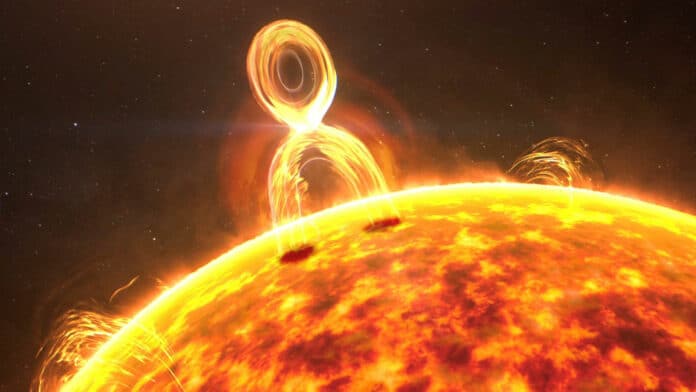Researchers recreated small solar flares using twelve powerful lasers to understand the principles underlying an actual astronomical occurrence known as magnetic reconnection.
The universe is everything but “the immense expanse of space,” notwithstanding how familiar the phrase is. Although it may appear that celestial objects are few and far between, the universe is teeming with various materials, including charged particles, gases, and cosmic rays.
Magnetic reconnection, as its name implies, occurs when two antiparallel magnetic fields, i.e., magnetic fields moving in opposing directions, collide, split apart, and realign. Even while it sounds simple, the process is anything but tranquil.
Taichi Morita, assistant professor at Kyushu University‘s Faculty of Engineering Sciences and first author of the study, said, “This phenomenon is seen everywhere in the universe. At home, you can see them in solar flares or Earth’s magnetosphere. When a solar flare builds up and appears to ‘pinch’ out a flare, that is magnetic reconnection. Auroras are formed from charged particles expelled from the magnetic reconnection in Earth’s magnetic field.”
Nevertheless, many mechanisms underlying the phenomenon remain a mystery despite its frequent occurrence. Studies are being done, such as in NASA’s Magnetospheric Multiscale Mission, where satellites flown into the Earth’s magnetosphere are used to study magnetic reconnections in real-time. The rate of reconnection and how the magnetic field’s energy is transformed and dispersed among the plasma’s particles are still unknown.
An alternative to launching satellites into orbit is to create magnetic reconnections with laser-induced plasma arcs. The created plasma is too tiny and unstable to accurately analyze the phenomenon without suitable laser power, though.
Morita said, “One facility that has the necessary power is Osaka University’s Institute for Laser Engineering and their Gekko XII laser. It’s a massive 12-beam, a high-powered laser that can generate plasma stable enough for us to study. Studying astrophysical phenomena using high-energy lasers is called ‘laser astrophysics experiments,’ It has been a developing methodology in recent years.”
During experiments, scientists used high-power lasers to generate two plasma fields with antiparallel magnetic fields. They then focused on a low-energy laser into the center of the plasma, where the magnetic fields would meet and where magnetic reconnection would theoretically occur.
Morita said, “We are essentially recreating the dynamics and conditions of a solar flare. Nonetheless, by analyzing how the light from that low-energy laser scatters, we can measure all sorts of parameters from plasma temperature, velocity, ion valence, current, and plasma flow velocity.”
One of their most important discoveries was the observation of electrical currents appearing and disappearing where the magnetic fields collided, indicating magnetic reconnection. They also got information regarding the plasma’s acceleration and heating.
The group intends to continue its examination in the hopes that these “laser astrophysics experiments” will be more frequently employed as an additional or alternative method to study astrophysical events.
Journal Reference:
- T. Morita, T. Kojima, S. Matsuo, S. Matsukiyo, et al. Detection of current-sheet and bipolar ion flow in a self-generated antiparallel magnetic field of laser-produced plasmas for magnetic reconnection research. Physical Review E, DOI: 10.1103/PhysRevE.106.055207
